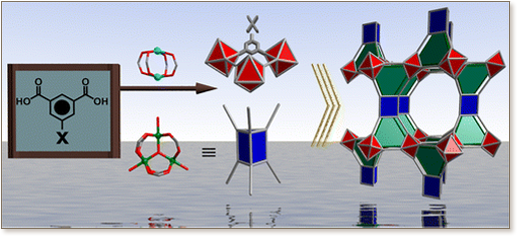

 A new and versatile class of metal–organic materials (MOMs) with augmented lonsdaleite-e (lon-e-a) topology is presented herein. This family of lon-e nets are built by pillaring of hexagonal two-dimensional kagomé (kag) lattices constructed from well-known [Zn2(CO2R)4] paddlewheel molecular building blocks (MBBs) connected by 1,3-benzenedicarboxylate (bdc2–) linkers. The pillars are [Cr3(μ3-O)(RCO2)]6 trigonal prismatic primary MBBs decorated by six pyridyl moieties (tp-PMBB-1). The three-fold symmetry (D3h) of tp-PMBB-1 is complementary with the alternating orientation of the axial sites of the paddlewheel MBBs and enables triple cross-linking of the kag layers by each pillar. These MOMs represent the first examples of axial-to-axial pillared undulating kag layers, and they are readily fine-tuned because the bdc2– moieties can be varied at their 5-position without changing the overall structure. This lon-e platform possesses functionalized hexagonal channels since the kag lattices are necessarily eclipsed. The effects of the substituent at the 5-positions of the bdc2– linkers upon gas adsorption, particularly the heats of adsorption of carbon dioxide and methane, were studied.
A new and versatile class of metal–organic materials (MOMs) with augmented lonsdaleite-e (lon-e-a) topology is presented herein. This family of lon-e nets are built by pillaring of hexagonal two-dimensional kagomé (kag) lattices constructed from well-known [Zn2(CO2R)4] paddlewheel molecular building blocks (MBBs) connected by 1,3-benzenedicarboxylate (bdc2–) linkers. The pillars are [Cr3(μ3-O)(RCO2)]6 trigonal prismatic primary MBBs decorated by six pyridyl moieties (tp-PMBB-1). The three-fold symmetry (D3h) of tp-PMBB-1 is complementary with the alternating orientation of the axial sites of the paddlewheel MBBs and enables triple cross-linking of the kag layers by each pillar. These MOMs represent the first examples of axial-to-axial pillared undulating kag layers, and they are readily fine-tuned because the bdc2– moieties can be varied at their 5-position without changing the overall structure. This lon-e platform possesses functionalized hexagonal channels since the kag lattices are necessarily eclipsed. The effects of the substituent at the 5-positions of the bdc2– linkers upon gas adsorption, particularly the heats of adsorption of carbon dioxide and methane, were studied.